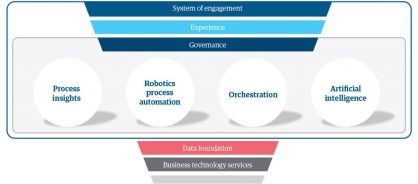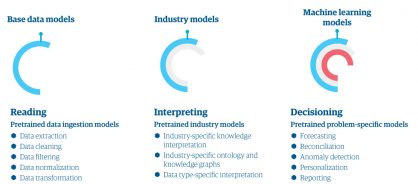- Point of view
The power of intelligent automation
Connecting people, process, and technology to accelerate digital transformation

For years, organizations have been working toward an automated future that frees people from time-consuming, manual work. Today, automation has moved from the factory floor into every enterprise to support better ways of working that fuel business growth.
Though automation is an essential part of digital transformation, it doesn't require a huge investment. A holistic, orchestrated approach will allow enterprises to make the most of the technology already at their disposal.
Many organizations start with robotic process automation (RPA) to automate high-volume, rules-based tasks. Though RPA has its benefits, it also has its limitations. That's why early adopters began to expand on RPA by:
- Incorporating industry and functional expertise into automation initiatives
- Introducing artificial intelligence (AI) and machine learning (ML) algorithms
- Adding in orchestration and governance layers
The result is intelligent automation. It combines a range of technologies to introduce automation within the context of a function or industry and create seamless end-to-end processes and experiences.
As HFS Research states, the "piecemeal approach to intelligent automation is contributing to scale challenges and results that are decidedly linear rather than the hoped-for and planned-for exponential benefits." According to its survey of 590 business leaders, only 11% are using solutions that combine the power of automation, analytics, and AI. To truly realize the power of intelligent automation, you must connect people, process, and technology.
Take a copy for yourself
Getting started
First, plan for an integration layer between new and existing technology to create a system of engagement between humans and machines. Think of this system of engagement as a single pane of glass that has humans on one side and machines and data on the other. It manages multiple processes, disparate data, and legacy systems to avoid the need for a large-scale implementation.
The main benefits of starting an intelligent automation initiative this way include:
- Easier integration across systems of record – including legacy enterprise resource planning (ERP) and cloud apps
- Full visibility and control over an entire end-to-end process
- A single place for managing process rules
- The ability to unlock new data-driven insights
Greater than the sum of its parts
Built upon a system of engagement, an intelligent automation engine uses existing technology to process vast amounts of data, rapidly handle complex workflows, and adapt to ever-changing business environments. You can create this engine by following these steps (figure 1):
- Experience: Consider how intelligent automation will improve end-user experiences to avoid automation for the sake of automation. Intelligent automation should help employees do their jobs more effectively, and as a result, customers and partners should enjoy efficient and personalized services. When you put the needs of people first, you can deliver experiences that exceed expectations, inspire loyalty, and increase profits.
- Governance: Take time to plan the governance strategy that will oversee your hybrid human and digital workforce. Only with proper governance can you make sure everything performs as expected, build trust in automation, and protect your return on investment.
- Process insights: Process mining and process discovery can help you decide what to automate and why. Process mining pulls event logs from ERP systems. Process discovery can track the physical actions of employees. Combined, they can create a visual representation of an end-to-end process to flag what is and isn't working so your intelligent automation engine is working in the right places.
- RPA: Remember that RPA is still a crucial part of intelligent automation. RPA bots are essential for taking over transactional activities – like data entry or copying data across systems – to allow your employees to focus on more strategic tasks.
- Orchestration: This step automatically coordinates and manages computer systems, middleware, and services as part of a larger workflow. This means that a person is notified if there's a transaction that a bot cannot process. Combining orchestration with RPA in this way creates flexible, long-lasting solutions and bots that can self-manage exceptions.
- AI: If you're lacking structured data, AI can help. In our latest study, AI 360: Hold, fold, or double down, an improved ability to use data and analytics is the second most significant benefit of AI according to 500 senior executives. You could use intelligent-document processing to read and extract information, conversational AI to understand customer intent, and ML to handle data variations. All of which frees up time for your employees.
- Data foundation: A strong data foundation is essential for protecting data quality. The AI 360 report finds that although almost two-thirds of senior executives say that their companies find it at least somewhat easy to extract, clean, and use relevant internal and external data, only 11% say it is very easy. Therefore, data specialists are often needed to source, clean, and prepare data for the automation engine.
- Business technology services: These are the software, systems, and infrastructure necessary for day-to-day work, including enterprise application services and cloud-based databases. Automation projects must integrate with business technology services to avoid lengthy ERP integration
Figure 1: The intelligent automation engine

Accelerate your transformation
You don't have to start from scratch to build your intelligent automation engine. Enterprises can use pretrained AI accelerators (figure 2) to quickly automate even complex end-to-end processes.
Pretrained AI accelerators are modular technological building blocks that have industry and digital expertise built in. For instance, there are data ingestion models for extraction, cleansing, and normalization to prepare raw data for use with AI. There are also decision-making models that use ML for forecasting, reconciliations, anomaly detection, and reporting. They allow businesses to develop solutions that automate common yet critical tasks at speed.
With an intelligent automation strategy in place, it won't be long before you see the benefits. Working together as a hybrid workforce, people and machines can deliver greater value to your business. And, as operations mature, you can refine your strategy to continuously optimize and improve end-user experiences.
Figure 2: Pretrained AI accelerators in action

Intelligent automation in action
Almost every business has a need for intelligent automation, and finance and accounting teams are a good place to start. At a leading global retailer, a mix of disconnected legacy systems and manual processes made it difficult for employees to manage a high volume of supplier and customer invoices leading to millions in cash leakage and write-offs. With a focus on improving the employee experience, the retailer introduced intelligent automation to power a single, scalable platform to streamline invoice management and give full visibility of payment status. This has reduced cash leakage and cut processing time from weeks to hours.
At one of the world's largest and most innovative aerospace manufacturers, intelligent automation is helping the business drive down costs, improve product quality, and enhance productivity. Built on a center of intelligent automation excellence, the manufacturer has achieved productivity savings of 30–50%. With a five-year plan to expand automation throughout the entire enterprise, the company expects to automate around 200,000 hours of work and achieve $200 million in savings.
But remember, for intelligent automation to be successful, it's important to adopt a holistic approach that draws on industry expertise to improve the end-user experience. When you successfully connect people, process, and technology in this way, you can boost productivity, unlock innovation, and transform experiences at scale.